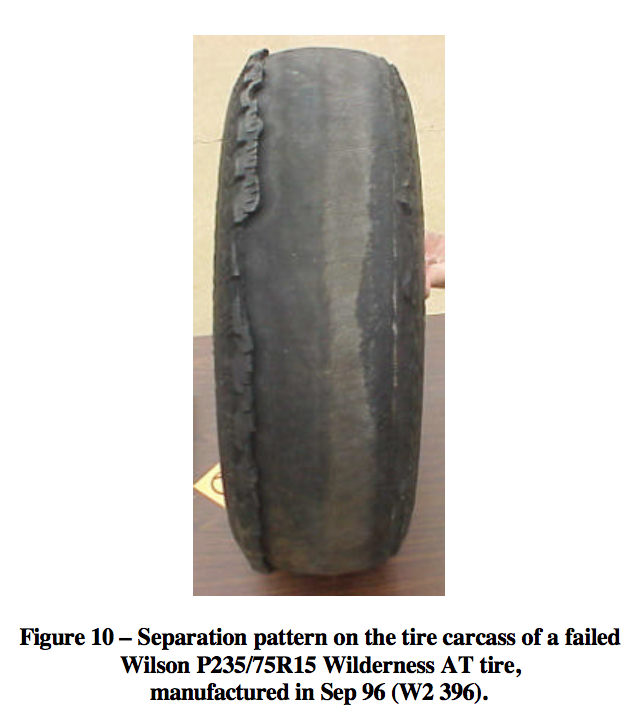�ޥ�:
|
�@��sutl
�O�ܡH
�֯S�N���g���F�ξA�A�N�ܦhSUV����t�L���]�w�b26psi�A���G���ͤF�ܦh�z�L�ƬG�A�̫��o�ǨƬG�������L�tFIRESTONE�A�ɭPFIRESTONE���v��}���C
|
�o�O����ʬ�W���G
On March 6, 2000 NHTSA began a preliminary inquiry[17] and on May 2, NHTSA began an investigation (PE00-020)[2] concerning the high incidence of tire failures and accidents of Ford Explorers and other light trucks and SUVs fitted with Firestone Radial ATX, ATX II, and Wilderness tires.[2] On August 9 Firestone recalled all ATX and ATX II tires and all Wilderness AT tires manufactured in Decatur, IL. On August 31, 2000 the Office of Defect Investigation (ODI) upgraded the investigation to an Engineering Analysis (EA00-023) to determine whether Firestone's recall covered all the defective tires.[2]
Ford and Firestone both issued root cause analyses to NHTSA.[2] Firestone argued that vehicle weight, tire design, low recommended inflation pressure, and lower tire adhesion for tires manufactured at the Decatur, IL factory contributed to the tire failures. Ford argued that the tire design led to higher operating temperatures compared to similar tires manufactured by Goodyear and that differences in manufacturing at Decatur led to weaker tires that were more prone to failure. Ford also argued that the size of the wedge, a strip of rubber between the first and second belts, is smaller in Firestone tires than Michelin tires making them weaker than comparable Michelin tires.
Publicly Firestone argued that Ford's recommended 26 psi inflation pressure was too low and should have been 30 psi.[7] In addition Firestone argued that the Explorer was abnormally dangerous and prone to rollovers in the event of a tire failure, leading to more injuries and fatalities. In the words of Firestone CEO John Lampe, "When a driver of a vehicle has something happen such as a tread separation, they should be able to pull over not rollover."[18]
Ford argued that the Explorer was no more dangerous than any other SUV[19] and that the accident rate for Explorers with Goodyear tires was far lower than for Explorers with Firestone tires.[20] Ford also argued that there was something wrong with the design of Firestone tires and with the manufacturing of those tires at the Decatur, IL factory.
Some outside observers speculated that both parties were to blame suggesting that[14] Firestone's tires being prone to tread separation and failure, and the Explorer was especially prone to rolling over if a tire fails at speed compared to other vehicles.[21]

26 psi �P 30psi ���M�i�H�t�Z�o��j�H �u�N�~�ڡI
�^�U�U��C���}���e���ӥJ���ˬd�L���I �H�K....
����F�A �����P��Էūפ]�|�v�T���l�樮�ɪ��L���A�u���n�D�`�p��!